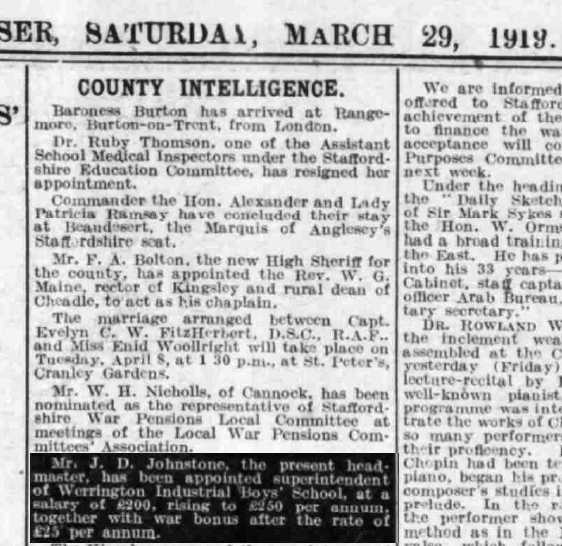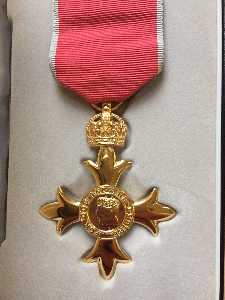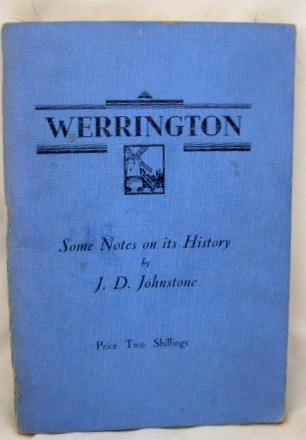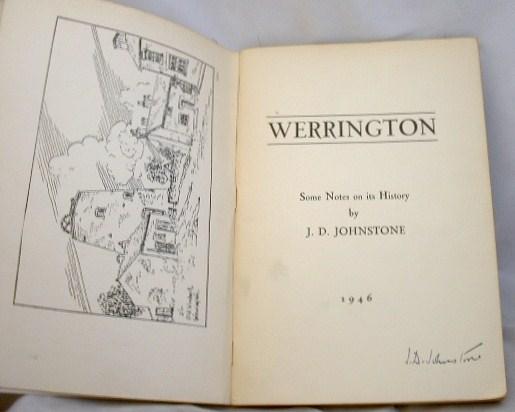Industrial Alien
John
Douglas Johnstone
Written and researched by David
Bohl,
with the kind help of the historians of Werrington.
Born
in Carlisle, 1885 John Douglas
Johnstone(JDJ)
was a pupil teacher at the age of 15 and took up a teaching post in
Liverpool before WW1. He was a founder member
and captain of The Alien5
Rugby Club from
1908-11. He boarded at 94 Rosslyn St,
Toxteth with fellow team member Hugh Mitchell and married in
1913
to Toxteth girl Ellen Cherry in Carlisle.
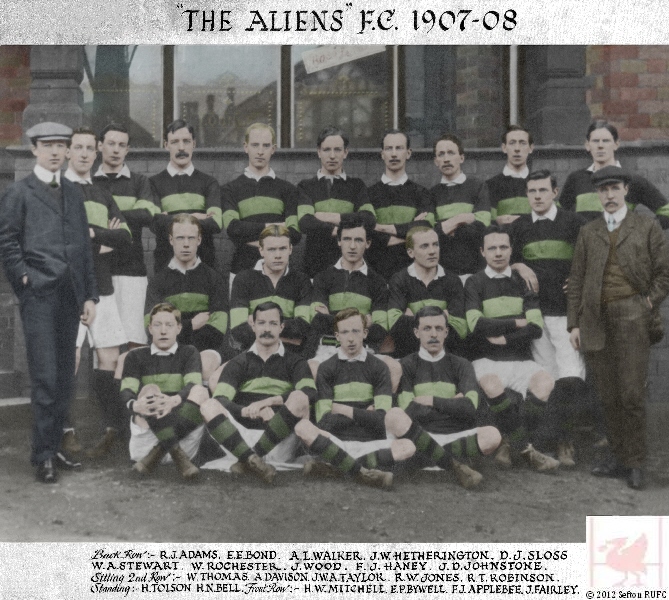
(Colours
were black with an emerald
hoop)
Looking at the many match reports and considering he was down as a
forward, JDJ was a gifted runner and kicker.
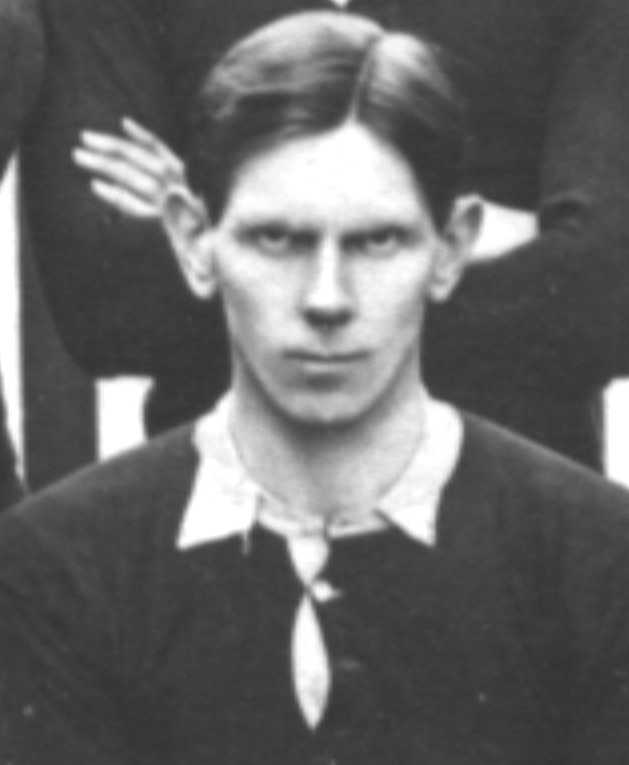

BIRKENHEAD PARK 4th v.
ALIENS
At
Lower Park, Birkenhead; 3 30.
Park: Back, C.H.Stewart; Three-Quarters,
C.Jones, A.M.Legge,
W.R.Gibbings, and
G.H.Raschen; Halves, H.O.Pain
and T.F.Dod; Forwards, G.Jones,
F.H.Kendall, H.D.Ryalls,
R.P.Ziegler, G.Urmson, P.W.Griffiths, and F.M.M’Crindell.
Aliens: Back, H.W.Mitchell;
Three-Quarters,
J.Wood,
J.W.A.Taylor(capt.), H.Tolson,
and F.J.Applebee; Halves, J.P.Scott
and E.E.Bond; Forwards, J.Fairley,
J.W.Hetherington,
J.D.Johnstone,
R.W.Jones, R.T.Robinson, W.A.Stewart, W.Thomas, and
A.L.Walker.
(Liverpool
Daily Post and Mercury Saturday
28th September 1907)
LIVERPOOL
SECOND DOWN
Judging by their display at
Clubmoor against the Aliens,
Liverpool
second string would seem to be bent on emulating the recent
performances of the senior fifteen. Granted they had a team depleted in
the three-quarter and forward line, and, granted also that the Aliens
played greatly ahead of their usual form, the fact remains that
Liverpool seconds were miserably weak. At full-back Montgomery was not
reliable, while the threes were a moderate lot. Two Liverpool
University players at half made little improvement, Crawford in
particular doing practically nothing with the exclusion of a good try
for goal from a place in the second half. Of the forwards, Crean and
Darbyshire were the best of the bunch. The homesters, as has been
indicated, played really well, and won 29-0, the fine goal kicking of
Fairley being responsible for many of the points, Johnstone
got four
tries, causing much amusement
by the cool way he planted just as
he was
collared by an opponent. Robinson(twice) and Stewart were the others to
cross. Brown at back was always safe. The three-quarters and halves
worked splendidly, Bonney standing out prominently while the forward
line were eminently satisfactory.
(Liverpool Daily
Post and Mercury 1st March 1909)
THE
ALIENS v WATERLOO 'A'
The Aliens are weekly adding to
their laurels, and at
Clubmoor, on
Saturday, had the satisfaction of administering a 21-3 licking of an
"A" team from Waterloo. Throughout the game the Aliens attacked
consistently, whereas Waterloo trusted to unexpected rushes on the home
line to gain them their points. At three-quarter and half they were
inferior to the schoolmasters, whose doings were watched with
considerable interest by Mr
J.G.Legge, director of education.
Johnstone
ran in a brace of tries. The
finest try of the afternoon was by
Tolson,
and others to cross were Robinson and Bonney. Fairley again carried off
the honours in the goal kicking line, improving three of the five tries
scored. Waterloo had plenty of chances, but their combination was poor,
and their only score was an unconverted try, the wind being responsible
for the failure of the kick.
The Aliens scored a runaway
victory over Waterloo thirds after
having all the game. The Aliens securing 30 points to 8 points for
Waterloo.
(Liverpool Daily
Post and Mercury 15th March 1909)
ALIENS
IMPROVED FORM
The Aliens have improved
greatly in the last few weeks, and
there is more method in their game plan, especially they are to be
commended for rallying round a comrade attacked. Unity is strength, and
this was proved time after time at Clubmoor on Saturday. Again there
was no selfishness in their play, for no matter who had the ball, the
player never rushed pall-mall, on his own, to certain disaster, but
parted with the leather as occasion demanded. This enabled them to play
three parts of the time in their opponents territory. Not that
Cosmopolitan were weak; indeed, it was their very robust play that
tended to keep the Aliens so active. To single out two particular
players, J.D.Johnstone
must be given the palm, on
the one hand for fine
all round play and for his ready acceptance of a drop goal, and on the
other side to H.Gordon, the sprightly full back, whose sterling good
run was well rewarded with a try. Both sets of forwards were fairly
equal in the scrums, but the Aliens had the advantage in the back
divisions, this accounted for their win by 10 points to 3.
(Liverpool Daily Post and
Mercury 19th
December 1910)
ALIENS
OVERCOME LIVERPOOL UNIVERSITY.
The Aliens thoroughly deserved
their success against the
Liverpool
University, although they played below their best form. The 'Varsity
opened strongly, and looked like walking away with the spoils, but once
they got a grip of the game the homesters were more convincing. Their
forwards were smarter in their combination, and showed a better
understanding. The visiting forwards were a disjointed lot, working in
fits and starts, but even at their best they never compared with the
Aliens for judgement and understanding. The Aliens did all the scoring
in the first half. Croxford scoring the first try after a fine
individual effort by Johnstone,
the veteran cleverly
intercepting a
'Varsity pass. Ellis failed to convert from a difficult angle. After a
clever passing move in the first half, Croxford securing the try
between the posts for Bishop to convert. 'Varsity improved in the
second half and scored tries through Lee and Anderson, Moore failing to
improve on either kick. A feature of the game was the strong tackling
and kicking of the 'Varsity back.
(Daily Post 30/1/1913)
Annual
General Meeting held at Elm Bank, Oakfield May 27th
1913
Mr
Knipe was voted to the chair.
The
Election of Officers resulted as follows
|
President.
|
Mr
Legge
|
|
Vice
Presidents
|
Messrs
Adams, Booth, Camidge, Hendrie, Flenley, Johnstone,
Kay,
Knipe, Kearns,
Morgan, Milbourn, Patterson, Nicholas, Rochester, Röhrs,
Smith, Stringer, Madoc-Jones, Waldron, I.R.Williams, R.W.Jones
|
It
is difficult to pin a WW1 military
career to JDJ as all the available medals cards do not state a
full middle name except for a Lieutenant in the Royal Lancaster
Regiment who sadly died in 1917. There is also no record of him in the
National Union of Teachers War Service database.
Further
research thankfully finds him
again in 1919 joining a newly formed Masonic Lodge in Hanley, just
outside of Stoke-on-Trent.
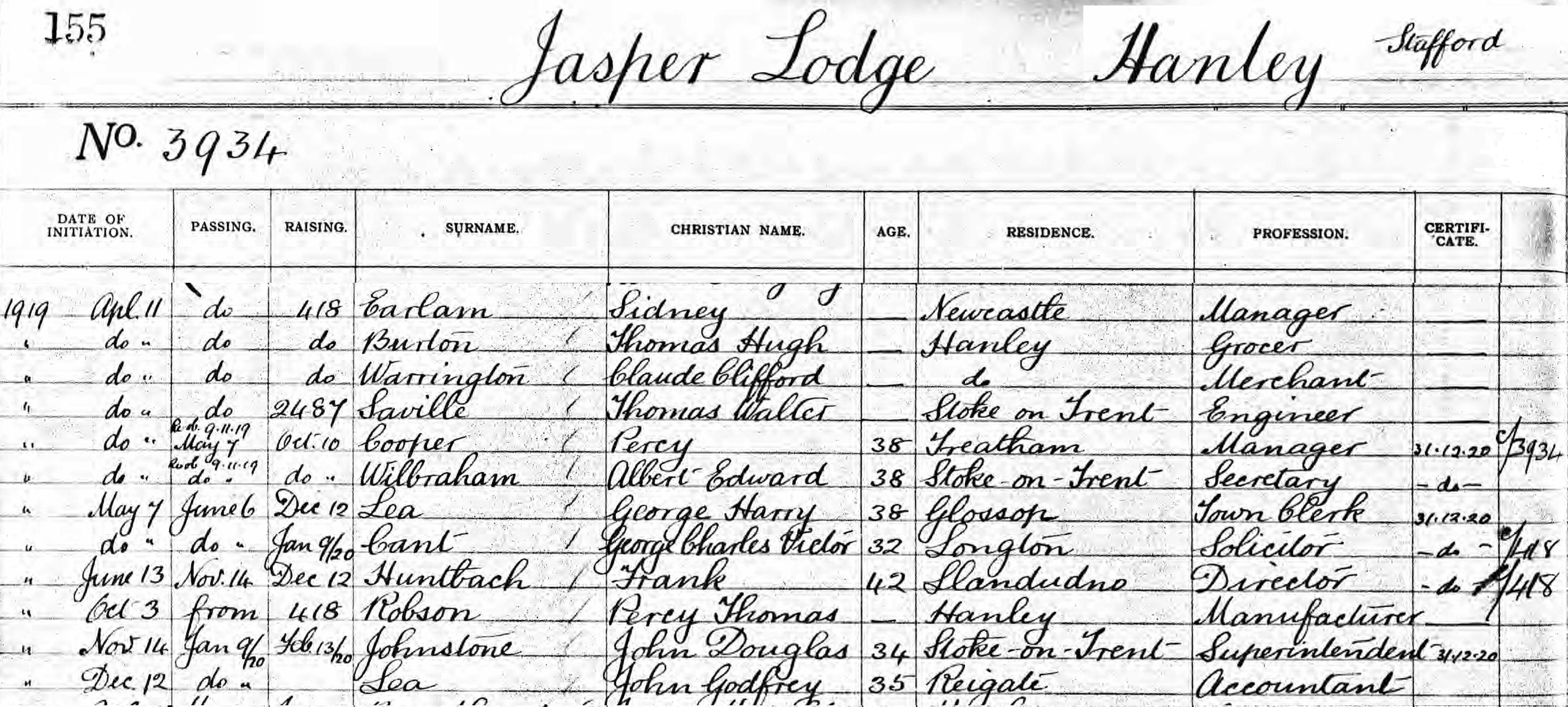
[Ancestry.com]
Jasper
Lodge had some prestigious
members and JDJ would have rubbed shoulders with Spitfire
designer
R.J.Mitchell who
was on the books until 1933.
The profession of "
Superintendant"
can be explained by his further appointment at
Staffordshire
County
Industrial School in Werrington,
i.e.promotion from Headmaster.
The fact that this may have been a Home Office appointment may well be
the reason why he did not serve King and Country.
In this snippet he explains the operation of Home Office Schools:-
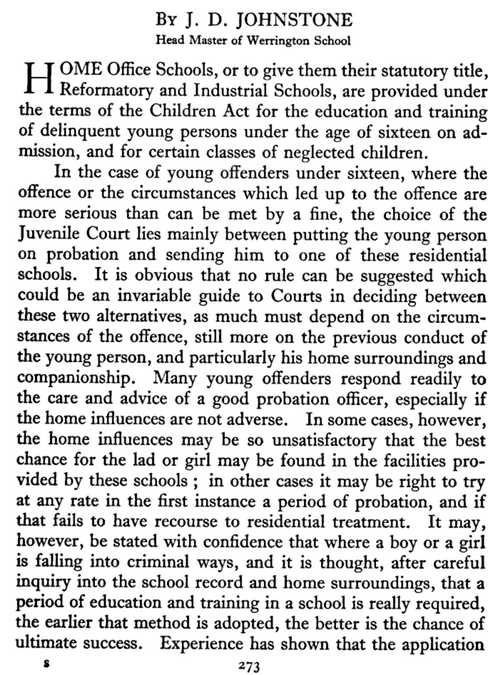
[First
Published April 1, 1931]
Mr and Mrs Johnstone became very involved in local affairs, the
Werrington Woman’s Institute was formed in 1923 and the first
president was Mrs Johnstone.
The decision to build a Village Hall was approved at a public meeting
held in 1931, and after years of fund raising the foundation stone was
laid by Mrs Johnstone in July 1937, the Hall was opened in the
following September. In the original governing document the
founder members of the Hall are listed and we now know the couple had
familiar names
"Nellie and Douglas
Johnstone".
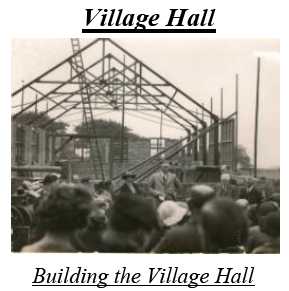 |
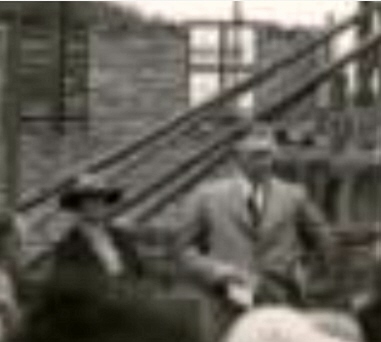 |
|
Grainy
photo of Nellie and Douglas |
[The
Werrington Book]
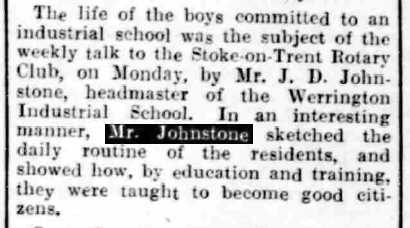
[June
1932]
JDJ's
professional and most
probably local activities were finally
recognized in 1934 when he was awarded the OBE.
|
|
|
Order
of the British Empire
|
JDJ was appointed Air Raid Precaution Warden before the outbreak of WW2.

[1939
Register - Ancestry.com]
The
Staffordshire Advertiser of 17 March
1945 runs an article on 'North Staffs
Field Club — New President Nominated'
in which it says,
'...
for the ensuing year, to succeed
Dr. A. Hilton John, Mr. Johnstone, who is headmaster and superintendent
of the Werrington Approved Boys' School, where
he has been since
1913,
has done a good deal of historical research work...'
(This
once again endorses why JDJ was excused WW1 service)
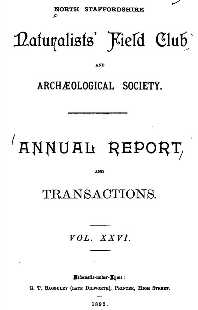
|
|
|
 |
|
June
1945
|
Dec
1946
|
Sept
1948
|
After
the war Mrs and Mrs Johnstone
continued in their quest of improving the quality of life for the
residents
of Werrington.
Darby
and Joan
The first meeting took place at the Village Hall on 25th October 1950
with just a handful of members. The clubs aim was to provide a
fortnightly meeting of the senior citizens in Werrington to get
together and socialise for a couple of hours. The club was formed by a
small group of ladies from the village who raised funds by baking and
selling cakes, organising raffles etc. and donations. The first
recorded donation in the accounts was for ten shillings from
J.D.Johnstone.
A rear extension to the Village Hall was built around 1955 consisting
of a kitchen, and two function rooms, one of which was named the
Johnstone Room (with oak panelling all round the room on the walls), in
memory of J.D.Johnstone who was the main instigator behind the building
of the hall, and an upper store room.
[The
Werrington Book]
Another
string to his bow was his
appointment to be the Chair of Cheadle Magistrates.
In
1954 Werrington
Approved School relocated to
Uttoxeter, JDJ may well have been
retired by then as he was living in Cheddleton, a bit further out of
town.
He passed away
in Stoke-on-Trent in 1959
Obituary
in Press: The death occurred
at the North Staffordshire Royal
Infirmary, Stoke-on-Trent. yesterday, of Mr John Douglas
Johnstone, of Cheddleton. near Leek, historian, magistrate and teacher.
He was 74.
(Our earlist
recorded Historian ! )
John
Douglas Johnstone OBE
(1885-1959)
Appendix
(apologies
for the quality of the OCR in places)
THE TEACHING OF ARITHMETIC
BY
FREDERICK FELIX POTTER
I am
indebted to Mr. J.
Douglas Johnstone,
the superintendent, for the brief account that follows. It
should
be noted in connection with this description that all the pupils at
this school are in residence — a fact which enables the "
shop "
to be used more frequently and more incidentally than would be possible
in a day school.
A SCHOOL SHOP
It is generally conceded in these days that it is applied and concrete
arithmetic that has to be taught, and practical work in this subject
now occupies a prominent position in the curricula of many schools.
Such practical work frequently takes the form of exercises in "
Shopping " and the school shop is but a step further on.
THE TEACHING OF ARITHMETIC
There are two entrance porches to our school-room, and, as one of them
was seldom used as such, we resolved to use it as a shop. A long narrow
table was installed as the counter, and an old desktop placed at one
end. The scales, weights and measures in school-use received a
permanent place in the centre of the counter, and the fittings were
completed by the conversion of grocery boxes into shelves. "
Getting the stock ready was a most interesting and instructive time. We
collected jam jars, bottles of all kinds, tea and cocoa packets, sugar
and currant bags, starch boxes, match boxes, salt and syrup tins
— in fact, anything we could fill with substitutes for the
real
things. Jam jars were covered with gummed papers, and labelled "
Raspberry," " Marmalade," " Damson," etc. Pickle bottles were filled
with round pebbles and water ; the various packets filled with sand and
sealed up ; and the whole arranged on the counter and the shelves in a
business-like fashion. " The juniors supplied us with
hand-made
envelopes and paper bags, and pebbles sorted in sizes. These were used
as peas, lump sugar, sweets, currants or raisins according to size,
while the biggest of all were labelled " Potatoes " or " Eggs." One
class produced some very creditable plasticine bananas, pies, biscuits,
bars of chocolate, cakes — even chops. The same material was
used
for butter, margarine, cheese and lard, and weighed out when ordered. A
good supply of sand was obtained, stored in biscuit tins, and used as
flour, coffee, sugar, etc. For milk, vinegar, and paraffin oil we used
water which we kept in a bucket. Articles of clothing, games, pocket
knives, balls, toys, etc., were borrowed from the boys, while some of
the articles made in the manual training classes were added to the
stock. " As soon as the collection of the stock and the
arrangement of the shop were well in hand, a few of the senior boys
were set to work preparing price tickets, bill heads, and the price
list. When all was ready the staff was chosen. We appointed a manager
from the seniors and an assistant manager from the juniors. They were
responsible for the shop, its arrangement, and cleanliness. Others on
the staff were two assistants, a clerk, and a commissionaire.
"
The actual shopping was a matter of no little difficulty, but we
ultimately adopted the following method. A time table was drawn up to
arrange that each class in the school would have the use of the shop on
one half-day every week. Three or four customers only were allowed to
go shopping at once, so that their temporary absence from their class
did not materially affect their class work. The teacher in the early
stages was in frequent ---------- Most teachers
will have
already prepared their own all-practical examples, but for the sake of
the younger teachers we print in an appendix to this book, by the
courtesy of the Superintendent, Mr. J. D.
Johnstone,
a set of examples in actual use at Werrington Industrial School,
Stoke-on-Trent. The History of English Weights and Measures.
A knowledge of syllabuses and methods at present in com- mon
use
in our elementary schools reveals to us the excel- lent developments
that have been made within a genera- tion in the teaching of English
weights and measures. Much mechanical teaching of course still
persists, and much aimless reduction through the whole length and
breadth of a " table " is still the introduction of many children to
what ought to be a real and fascinating
LIST OF ALL-PRACTICAL EXERCISES IN USE AT WERRINGTON
INDUSTRIAL
SCHOOL, STOKE-ON-TRENT
The appended list of All-practical Exercises is printed by the courtesy
of Mr. J. D.
Johnstone, Superintendent of
.the Werrington Industrial School,
Stoke-on-Trent. All the exercises are actually in use there
substantially in the form introduced by Mr. Johnstone
1. How much longer
is your foot than that of the boy next to you ? If you draw a line on
the
floor 12
of your feet long, and he drew a line 12
of his
feet long, how much longer would your line
be than
his ? Do it and see if you are right.
2. What
is the distance round this card ?
Measure
the shortest distance between the opposite
corners. Put 4 cards together to make a rectangle four times the area
of this one. How far is it round this rectangle ?
3. Find
as carefully as you can find the distance
round this T-square.
4. Work
with another boy and take each other's
measurements : head, neck, chest ("up and down "), waist, thigh, knee,
calf, ankle, " muscle," and wrist.
5.
Measure the diameter of this ball, pipe, jam jar,
cylinder. Callipers.
6. Here
is a match-box, carefully open it out, and
with this cardboard make one similar
7.
Measure the length and breadth of the platform
(or top of cupboard, desk, floor, etc.), find the distance all
round it.
8. How
much farther is it round the top of
the table than round the top of the stool ?
9. What
height are you ? How much higher are the
blackboard and the door ?
10. If a
fly walked from a corner of your book
right
round the edge till it came to the corner at
which it
started, and then walked to the opposite
corner,
how far has it gone ?
11.
Estimate the lengths of the cupboard, floor,
a desk,
the heights of the door, the window, the
board,
your teacher. Write your answers down.
Now
measure them and compare your results.
12.
Here is a book. Estimate how much string
you
would need to tie it up, allowing 3 inches for
the
knot. Now do it and see if you were
right.
13. How
far can you span ? Measure the
length
of the desk by spanning. Measure it next
with a
ruler. Were you nearly right ? Which
has the
larger span, your right hand or your left ?
How much
larger ?
14. Take
ten ordinary steps from a chalk line.
How far
have you gone ? How long was each
step,
supposing each was the same length ?
Remember
how long your step is.
15. How
high do you think the room is ? Get
a long
stick and measure it.
16. I
want to put a skirting board or picture
rail
round the room. How long will it be ?
17. Take
all the measurements you want to
make a "
ruler " drawing of the door (window,
picture
frame).
18. Draw
a triangle, an oblong, a circle, a
square.
Out them out and find the distance all
round
(use thread for the circle).
19.
Obtain a map of England. Measure the dis-
tances
from (a) London to Stoke, (b) Carlisle to
Newcastle,
(c) Bristol to Hull.
20. Here
is a piece of string. Tie six knots in
it.
Measure it now. How much string does a
knot
take up ?
21. Here
is a piece of string. Make a square
with it.
How long is one side ? Make a triangle
with
three equal sides. How long is one side ?
22. How
long would 20 pencils be if placed end
to end ?
All Aliens RFC, Seft0n
RUFC
photographs, programmes and memorabilia Copyright © 2012
Sefton RUFC



